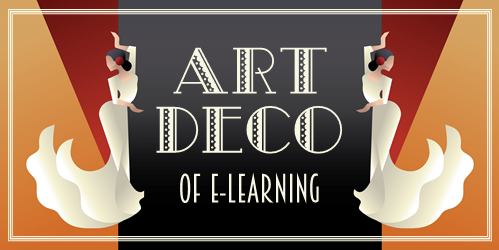Is This a Problem with E-Learning Today?
Author:
Go to Source

I ran across two articles recently that made me wonder about the state of today’s e-learning courses.
The first article was on how websites are all starting to look the same. They did a study to confirm it. In the second article, the author makes some good points on how a lot of this new design is sterile and lacks personality.
While the two articles dealt with website design, there are a lot of parallels to e-learning course design.
Why Does Everything Look the Same?
There are a number of reasons why things look the same.
- There’s a commonality to design because of trends, but they come and go. A few years ago everything had bevels, then glossy buttons, then reflections, then skeuomorphic, then anti-skeuomorphic, then neuomorphism, and on and on. People design based on trends to look fresh and modern.
- A lot of design follows a templated structure with layouts, grids, and common understanding of user interface (UX) design. There’s all sorts of new understanding and rules for UX design based on research and an evolving industry. In addition, courses have technical requirements and need to be designed to accommodate mobile and accessibility needs.
- The technology is changing. If you want a nice-looking website, you don’t need to be a programmer. Just sign up for Wix or Squarespace. Same thing with e-learning courses. Gone are the days of specialized course developers. I addressed that in this post on the next generation e-learning tools. The tools like Rise 360 and Rise.com are becoming more prevalent. They offer easy, form-based construction. And with that is a consistent look and feel of the courses. You don’t need to know design, you assemble your learning content and pretty much plug and play.
Looking the Same Isn’t Bad Is It?
As noted above, there are a lot of legitimate reasons why things look the same. And those aren’t bad. And the reality is that things will evolve as the industry evolves and develops new norms. Plus, people will get tired of the way things look.
David Anderson shares a funny observation on how to be a consultant. If everything your client has is square, you tell them, what they need is a circle. And if all they have is circles, you tell them what they need is a square. There you go, consulting 101: if your design is skeuomorphic, you need flat. If your design is flat, try skeuomorphic.
Things change and what’s big today won’t be tomorrow.
Legitimate Concerns
“We are emotional and sentimental beings; we survive on self-expression.” – Tobias Van Schneider
I’ve met plenty of clients or “experts” on user experience design who follow a bunch of rules and won’t budge from them. Or marketing people with some ridiculous branding requirements for their courses. What happens is that the objective of learning is lost in the rules and requirements dictated by other objectives from people not concerned about teaching. Because of this, courses become boring and sterile. They lack life and are not very engaging for the learner. And it’s just as bad for the person tasked to build them.
An e-learning course is about teaching PEOPLE (at least in an ideal world). Regardless of current design trends, we should build learning experiences that are relevant and human. And for the course author, we yearn to be creative and want jobs that are more than just copying and pasting content from one medium to the next.
We have to work within the context of what we have. The person who possesses custom programming skills, has more options. But that’s not where most of us are at. However, just because we have constraints doesn’t mean we can’t be creative. In fact, I often find that constraints force more creativity than having none.
My big question for e-learning today: what is the Art Deco of e-learning design? Or better yet, what can we do to get away from sterile courses and make them more human-centered? How can we can exercise our creative skills and build courses that are both engaging and successful? Interested in your thoughts.
Download the fully revised, free 63-page ebook: The Insider’s Guide to Becoming a Rapid E-Learning Pro
Upcoming E-Learning Events
April 20 & 21(Brisbane). Postponed until September. Details coming soon. Articulate Roadshow: Learn more and register here.April 23 & 24(Melbourne). Postponed until September. Details coming soon. Articulate Roadshow: Learn more and register here.- November 9 &10 (London). Details coming soon.
Free E-Learning Resources
 |
 |
 |
|
Want to learn more? Check out these articles and free resources in the community. |
Here’s a great job board for elearning, instructional design, and training jobs |
Participate in the weekly elearning challenges to sharpen your skills |
 |
 |
 |
|
Get your free PowerPoint templates and free graphics & stock images. |
Lots of cool elearning examples to check out |
Getting Started? This elearning 101 series and the free e-books will help. |
